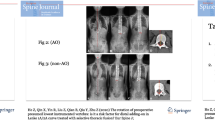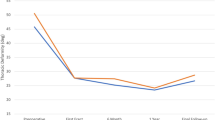Abstract
Purpose
To identify the characteristics and the incidence of adding-on (AO) in atypical Lenke 1A adolescent idiopathic scoliosis patients, and to investigate whether atypical and typical Lenke 1A curve should follow the same lowest instrumented vertebra (LIV) selection strategy.
Methods
A total of 251 Lenke 1A patients who underwent posterior spinal fusion were analyzed. The minimum follow-up was 2 years. Curves were classified into two groups according to the apex. At last, 42 atypical Lenke 1A patients (apex at T10/11–T11/12) were identified and divided into atypical group (G1). Meanwhile, 42 age, gender, and Cobb angle-matched typical Lenke 1A patients (apex at T7/8–T10) were enrolled into the typical group (G2). The radiographic characteristics were evaluated, and the incidence of AO was compared between the 2 groups.
Results
The incidence of atypical Lenke 1A curves was 16.7%. Patients in G1 were found to have more left thoracic curves (P = 0.029), better flexibility of thoracic (P = 0.011) and lumbar curve (P = 0.014), and more preoperative coronal imbalance (P = 0.001). At the final follow-up, G1 developed more AO (38.1% vs. 19.0%). Specificity, for patients with LIV proximal to last substantially touching vertebra (LSTV), the incidence of AO was significantly higher in G1 (82.4% vs. 42.9%, P = 0.022).
Conclusion
Atypical Lenke 1A curve had its own radiographic characteristics. It was more likely to develop AO when LIV was proximal to LSTV, which indicated different fusion levels should be considered in these two subtypes of Lenke 1A. We recommended LSTV as LIV in atypical Lenke 1A cases, while one level proximal to LSTV might be available in typical Lenke 1A curve.
Level of evidence
3


Similar content being viewed by others
Availability of data and material
Not applicable.
References
Lenke LG, Betz RR, Harms J, Bridwell KH, Clements DH, Lowe TG, Blanke K (2001) Adolescent idiopathic scoliosis: a new classification to determine extent of spinal arthrodesis. J Bone Joint Surg Am Vol 83(8):1169
Cummings RJ, Loveless EA, Campbell J, Samelson S, Mazur JM (1998) Interobserver reliability and intraobserver reproducibility of the system of King et al. for the classification of adolescent idiopathic scoliosis. JBJS 80(8):1107
Lenke LG, Betz RR, Bridwell KH, Clements DH, Harms J, Lowe TG, Shufflebarger HL (1998) Intraobserver and interobserver reliability of the classification of thoracic adolescent idiopathic scoliosis. JBJS 80(8):1097–1106
Sponseller PD, Flynn JM, Newton PO, Marks MC, Bastrom TP, Petcharaporn M, McElroy MJ, Lonner BS, Betz RR (1976) Harms Study G (2012) The association of patient characteristics and spinal curve parameters with Lenke classification types. Spine (Phila Pa) 37(13):1138–1141
Fujimori T, Bastrom TP, Bartley CE, Newton PO, Group HS (2014) Comparison of typical thoracic curves and atypical thoracic curves within the Lenke 1 classification. Spine Deform 2(4):308–315
Alam M, Newton PO, Yaszay B, Bastrom TP, Group HS (2013) Are thoracic curves with a low apex (T11 or T11/T12) really thoracic curves? Spine Deform 1(2):139–143
Qin X, Sun W, Xu L, Liu Z, Qiu Y, Zhu Z (2016) Selecting the last “substantially” touching vertebra as lowest instrumented vertebra in Lenke Type 1A curve. Spine 41(12):E742–E750
Murphy JS, Upasani VV, Yaszay B, Bastrom TP, Bartley CE, Samdani A, Lenke LG, Newton PO (2017) Predictors of distal adding-on in thoracic major curves with AR lumbar modifiers. Spine 42(4):E211–E218
Kwan KYH, Wong CP, Koh HY, Cheung KMC (2019) Selection of lowest instrumented vertebra using fulcrum bending radiographs achieved shorter fusion safely compared with the last “substantially” touching vertebra in Lenke type 1A and 2A curves. Spine 44(24):E1419–E1427
Lowe TG, Lenke L, Betz R, Newton P, Clements D, Haher T, Crawford A, Letko L, Wilson LA (2006) Distal junctional kyphosis of adolescent idiopathic thoracic curves following anterior or posterior instrumented fusion: incidence, risk factors, and prevention. Spine 31(3):299–302
Sun X, Liu W-j, Xu L-l, Ding Q, Mao S-h, Qian B-p, Zhu Z-Z, Qiu Y (2013) Does brace treatment impact upon the flexibility and the correctability of idiopathic scoliosis in adolescents? Eur Spine J 22(2):268–273
Wang Y, Hansen ES, Hoy K, Wu C, Bunger CE (2011) Distal adding-on phenomenon in Lenke 1A scoliosis: risk factor identification and treatment strategy comparison. Spine (Phila Pa 1976) 36(14):1113–1122
Lenke LG (2007) The Lenke classification system of operative adolescent idiopathic scoliosis. Neurosurg Clin N Am 18(2):199–206
Sponseller PD, Flynn JM, Newton PO, Marks MC, Bastrom TP, Petcharaporn M, McElroy MJ, Lonner BS, Betz RR, Group HS (2012) The association of patient characteristics and spinal curve parameters with Lenke classification types. Spine 37(13):1138–1141
Cho RH, Yaszay B, Bartley CE, Bastrom TP, Newton PO (2012) Which Lenke 1A curves are at the greatest risk for adding-on and why? Spine 37(16):1384–1390
Acknowledgements
This work was supported by the Natural Science Foundation of Youth Fund Projects of Jiangsu Province (BK20190119); Jiangsu Provincial Key Medical Center (YXZXA2016009); National Natural Science Foundation of China (81772304, 82002260).
Funding
This work was supported by the Natural Science Foundation of Youth Fund Projects of Jiangsu Province (BK20190119); Jiangsu Provincial Key Medical Center (YXZXA2016009); National Natural Science Foundation of China (81772304, 82002260).
Author information
Authors and Affiliations
Corresponding author
Ethics declarations
Conflict of interest
The authors have no conflict of interest to declare.
Ethics approval
This study was approved by the university institutional review board.
Consent to participate
Authors consent to participate.
Consent for publication
Authors consent to publication.
Additional information
Publisher's Note
Springer Nature remains neutral with regard to jurisdictional claims in published maps and institutional affiliations.
Rights and permissions
About this article
Cite this article
Yin, R., Qin, X., He, Z. et al. Which thoracic curves are at the greater risk for distal adding-on: comparison between typical and atypical Lenke 1A curves. Eur Spine J 30, 1865–1871 (2021). https://doi.org/10.1007/s00586-021-06721-7
Received:
Revised:
Accepted:
Published:
Issue Date:
DOI: https://doi.org/10.1007/s00586-021-06721-7




